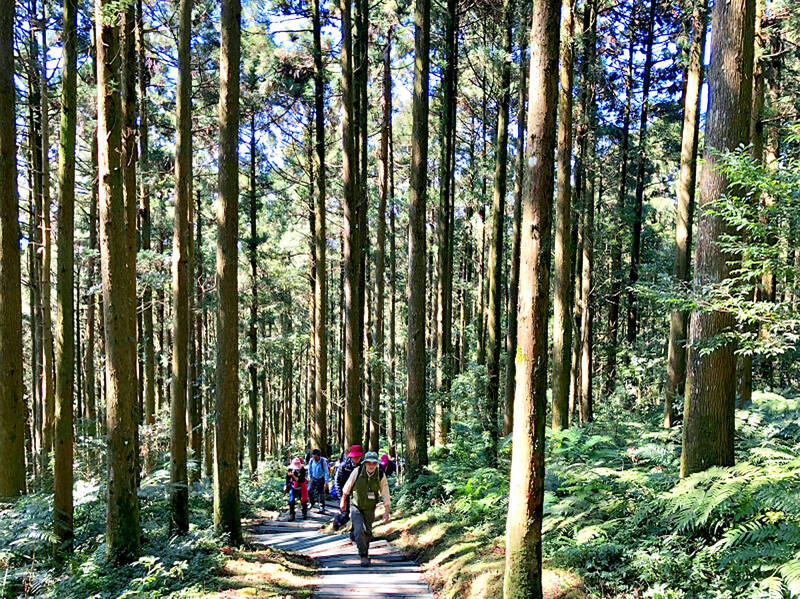《TAIPEI TIMES》 Agency lists top spots for hiking

People hike a trail on Dongyanshan in Taoyuan in an undated photograph. Photo courtesy of the Forestry and Nature Conservation
HOLIDAY EXERCISE: National forest recreation areas from north to south offer travelers a wide choice of sights to connect with nature and enjoy its benefits
By Yang Yuan-ting and Esme Yeh / Staff reporter, with staff writer
Hiking is a good way to improve one’s health, the Forestry and Nature Conservation Agency said, as it released a list of national forest recreation areas that travelers can visit during the Lunar New Year holiday.
Taking a green shower of phytoncides in the woods could boost one’s immunity system and metabolism, agency Director-General Lin Hwa-ching (林華慶) cited a Japanese study as saying.
For people visiting northern Taiwan, Lin recommended the Dongyanshan National Forest Recreation Area in Taoyuan’s Fusing District (復興).
Once an important plantation in the north, Dongyanshan (東眼山) has a number of historic monuments, he said.
The area is broadly covered by manmade forests of Japanese cedars and Chinese firs, creating a spectacular landscape under treetops, Lin said.
It also has trace fossils of shellfish and sea urchins that are about 30 million years old, as well as an abundance of bird species that birdwatchers would enjoy, he added.
For travelers in central Taiwan, Lin suggested visiting the Aowanda National Forest Recreation Area in Nantou County’s Renai Township (仁愛).
The area features bald cypresses and lots of indigenous maple woods, which form a colorful natural landscape in the autumn and winter, he said.
There are also many cherry trees in the area, and visitors might be able to catch sight of early cherry blossoms during the Spring Festival holiday, Lin said.
One of the must-see spots is the Aowanda Suspension Bridge (奧萬大吊橋) connecting to the pine woods, and people can enjoy a view of the valley and take photographs on the bridge, he said.
Travelers in the south should visit the Shuangliu Forest Recreation Area in Pingtung County’s Shizih Township (獅子), Lin said.
Shuangliu (雙流, literally double flow) refers to the two rivers — Daren and Neiwun — that intersect to form the upper stream of the Fonggang River (楓港溪), he said.
Visitors gravitate toward the scenic streams and waterfalls, and the negative ion-laden air in the area, Lin said.
The area was once populated by the Paiwan, so it is a rich repository of the indigenous people’s history and culture, including the ruins of a tortoise-shell house, a typical Paiwan architecture, he said.
Bird or butterfly watchers should also visit the area, as there are Formosan blue magpies, Taiwan hwamei and the rare, endangered golden birdwings, as well as more than 100 butterfly species, he added.
As for eastern Taiwan, Lin suggested visiting the Danongdafu Forest Park in Hualien County’s Guangfu Township (光復), where there are more than 1 million trees of nearly 20 varieties commonly seen in low-altitude regions.
During the Spring Festival holiday, the area is covered in blooming yellow rapeseed against a backdrop of a broad blue sky and the green mountains of Hualien County, making it a popular site for taking photographs, Lin said.
People visiting these forest recreation areas are advised to check the traffic and weather conditions in advance at the Taiwan Forest Recreation Web site to ensure a safe and pleasant journey, he added.
新聞來源:TAIPEI TIMES
















